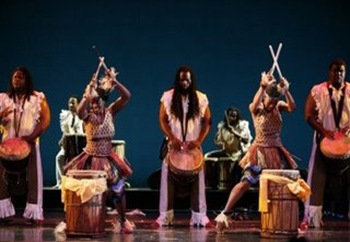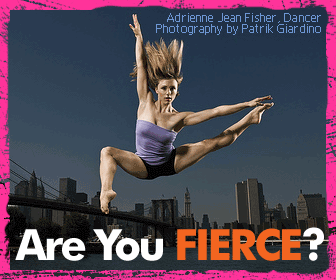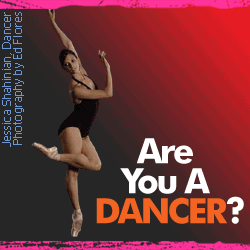Dance Review: Opening Up a Can of African Dance and Culture
June 1, 2009 by iDANZ Today
Filed under Concert Modern -Jazz-Contemporary, iDANZ Critix Corner -Dance Reviews, Other Dance, Reviews
Chuck Davis is the Don King of African dance. Either you work with him in his annual celebration of African dance, music and culture or you’ll end up fighting in dingy places à la Fight Club. It’s not that other dance artists in African culture are not actively working to bring African dance, music and culture to the US, but Chuck is actively working to bring those forces together.
In its 32nd revelation, DanceAfrica at BAM is like discovering an African burial ground in Manhattan. There is this sense of wonder, amazement and longing that says, "Here they are—the bones of African ancestors in America!" However, what we see on stage is not a dusty history lesson; it is a celebration of the living African presence in our community that respects youthful innovation in addition to the established pan-African dance creative artists and the authority of the elders.
The African rhythm is a force of nature that in dance blends live drumming, songs, shouts and woops with their corresponding place in the body. Limbs akimbo, colors flying and bodies moving distract and confound the senses while beauty and harmony bring grace at every turn. DanceAfrica 2009:Rhythmic Reflection: African Legacies Revealed boasts five performances featuring Evidence Dance Company, percussion and dance ensemble Farafina Kan, SeéWé African Dance Company and the youths at BAM/Restoration DanceAfrican Ensemble.
As is tradition, the night starts with the celebrants pouring libations on the front steps of BAM in order to bless the festival. An hour later inside BAM’s Opera House, the elders enter with Chuck amidst a large entourage of drummers and attendants. Chuck’s 6’5” frame decked out in a fabulous African grand buba starts his trademark call and response.
Call: Ago (which means “Attenion”)
Response: Amay (which means “I am listening”)
Once the crowd is really responding, he adds a song and dance combo—“Lean with it, rock with it, Umoja (Unity)”.
Rhythmic Reflection I: Farafina Kan 
Mahiri-Fadjimba Keita leads twelve drummers as they blaze through three rhythms of Yamama, Zaouli and Gbe Gbe. After the opening, the female drummers point their sticks up, down and then around into tails that shake like birds’ tails before slowly putting their sticks up one by one as they begin the dance. The ladies jump and shake with fast feet that’s characteristic of dance from Guinea and Côte D’Ivoire. The ladies return to the male drummers for a final drum finale in which they beat their drums with stick, hand and foot. Farafina Kan gives an amazing start to the night.
Rhythmic Reflection II: Memorial
Another tradition of the night is to pay homage to those dancer artists who have touched the festival, but have also passed on. While candle bearers walk slowly across the stage a voice reads the names of Alyo Tolbert, Dr. Pearl Primus, Lucille Ellis, Tommy Gomez, Talley Beatty, Gregory Hines, Lynn Jackson, Bob Marley, Dr Betty Shabazz, Alex Haley, Alvin Ailey, Ozzie Davis, Johnny Crochrin, Rosa Parks, Katherine Dunham, Walter Nicks, Sam Scripps, Jo Nash and several dozen more. Hearing those names spoken aloud is a powerful tribute to the body of souls who are still with us urging this festival and the community along.
Rhythmic Reflection III: BAM/Restoration Dance/Africa Ensemble
 This youth troupe of seasoned DanceAfrica performers is lead by Abdel R. Salaam. The twenty vibrant young bodies electrify the theatre performing, Rhythm Legacy: Book III—Club Legacy (2001). The work is long and evolved utilizing a driving house beat. Abdel showcases dance styles from Africa through all of the Diaspora. The children in his troupe are of varying ages, shapes and sizes, and they all work it. One quartet of four tall and very long-legged girls penche and tilt amidst a flurry of pops and rump shakes. The dancers work it out, and their energy never stops. I see African, Brazillian, Hip Hop, House, Breaking, Popping, Locking and lots of Hot Jazz. The seamless transitions say it all. To the young dancer its all dance; there are no walls, barriers, styles or hierarchy. These young DanceAfrica veterans hold the stage with the NYC professionals and African nationals, giving evidence of the connection between African dance and the movement styles of young African Americans.
This youth troupe of seasoned DanceAfrica performers is lead by Abdel R. Salaam. The twenty vibrant young bodies electrify the theatre performing, Rhythm Legacy: Book III—Club Legacy (2001). The work is long and evolved utilizing a driving house beat. Abdel showcases dance styles from Africa through all of the Diaspora. The children in his troupe are of varying ages, shapes and sizes, and they all work it. One quartet of four tall and very long-legged girls penche and tilt amidst a flurry of pops and rump shakes. The dancers work it out, and their energy never stops. I see African, Brazillian, Hip Hop, House, Breaking, Popping, Locking and lots of Hot Jazz. The seamless transitions say it all. To the young dancer its all dance; there are no walls, barriers, styles or hierarchy. These young DanceAfrica veterans hold the stage with the NYC professionals and African nationals, giving evidence of the connection between African dance and the movement styles of young African Americans.
Rhythmic Reflection IV: Honoring Mama Dr. Doris Green
Dr. Doris Green is issued a Proclamation from Congresswoman Leticia James and a Citation from Borough of Brooklyn President Marty Markowitz for her lifelong work of Laban, which notates African Music. An ensemble of children in beautiful luminous orange hued ceremonial costumes dance and help to present her awards and gifts. Dr. Green’s work, Green Notation, is used in dance departments all over the world from Ohio State to Ghana. Her struggle is to help preserve African music in a system that allows people “to hear it as it is” and not “the way the Western world wants you to think it is.”
Rhythmic Reflection V: Evidence, A Dance Company 
Upside Down (1998) with the music of Fela Kuti and costumes by Omotayo Wunmi Olaiya and Carolyn "Meckha" Cherry is a jaw dropping work that showcases Ron Brown’s raw dance vernacular. His steps are so amazing, and it seems the steps are purposefully done with a humble spirit so as not to mow the audience over. The work deals with the “uncertainty” of the destiny of a child. Always spiritual, the seven dancers are grounded in a fusion of African, house, and modern dance, which gives proof of why Ron, a Modern choreographer, is so beloved in the NYC African dance scene.
Rhythmic Reflections VI: SeéWé African Dance Company
Mouminatou Camara’s group is very beautiful to watch as the women work the fast Guinea footwork. The tall men enter and shake the cobwebs off the concept that male dancers are not strong and masculine. The women in the audience start hollering and rolling their tongues. Not since I studied with Amaniyea Payne (Artistic Director for Muntu, Chicago) have I seen a director take the stage and represent in this way. Suddenly, Mouminatou is on stage dancing with the men, and her small frame brings a supernatural force from her days of dancing with Les Ballet Africans. I have wondered when I would see the energy of the old Ballet Africans on stage. All at once she has the audience eating out of the palm of her hand as they close out the evening leading into the Grand Finale.
Rhythmic Reflections VII: Finale: Ensemble (all cast members dancing together)
Following another custom, all of the companies take the stage to perform a Grand Finale where they come forward in rows, each company giving a bow in each group’s own flavor. The Restoration group—the youngins—are jumping high and rolling around and back up to catch the rhythm again. Other groups do a cute ensemble bow. The vision of these performers coming together and showing the universality of basic African steps on one stage is mesmerizing.
Chuck offers thanks in the playbill…
This year, we celebrate over 32 years of DanceAfrica, and with the help of the OMNIPOTENT FORCE wherein lies our belief, we will continue beyond another 32 years or until time ceases to exist.
 Every Memorial Day weekend this cultural explosion not only bounces onto center stage at BAM, but also spills out into the surrounding area in one of the largest African bazaars of its kind. An estimated 30,000 people will come from all over the eastern seaboard. Vendors will sell clothes, music, books, food, crafts, African instruments and artifacts. As well, Caribbean, South American and African American culture is interspersed within the pan-African market. In the past, I have even gotten a pony ride from one of the Black Cowboys. Dance Africa is a rare juggernaut of economic enfranchisement for the Black community that is planned annually over a twelve-month period by the Council of Elders. Also, for the second year, five young artists will receive college scholarships from Samuel H. Scripps Foundation through BAM. The entire production has national and local sponsorship from Morgan Stanley, Bloomberg, ConEdison, Time Warner and Crunch.
Every Memorial Day weekend this cultural explosion not only bounces onto center stage at BAM, but also spills out into the surrounding area in one of the largest African bazaars of its kind. An estimated 30,000 people will come from all over the eastern seaboard. Vendors will sell clothes, music, books, food, crafts, African instruments and artifacts. As well, Caribbean, South American and African American culture is interspersed within the pan-African market. In the past, I have even gotten a pony ride from one of the Black Cowboys. Dance Africa is a rare juggernaut of economic enfranchisement for the Black community that is planned annually over a twelve-month period by the Council of Elders. Also, for the second year, five young artists will receive college scholarships from Samuel H. Scripps Foundation through BAM. The entire production has national and local sponsorship from Morgan Stanley, Bloomberg, ConEdison, Time Warner and Crunch.
Many readers are scratching their heads wondering why I am spending so much time on the financials….? Well, it is precisely because of these dazzling financials that this festival has viability and longevity. In the current economy where banks are failing, it brings a tear to my eye to see my people celebrating a sustainable arts festival. Rock on Baba Chuck. You are the Don King of the African American Dance world, and you just opened a can of whoop ass at BAM. Congrats to all the performers, organizers, vendors, community in attendance and especially the elders and youth!
Photo Credit: Julieta Cervantes
iDANZ Critix Corner
Official Dance Review by Sasha Deveaux
Performance: Dance Africa
Executive Producer: Chuck Davis
Music: Various live drummers and pop songs.
Venue: Brooklyn Academy of Music (BAM), Brooklyn, USA
Date: Friday, May 22, 2009, 7:30pm
www.iDANZ.com







